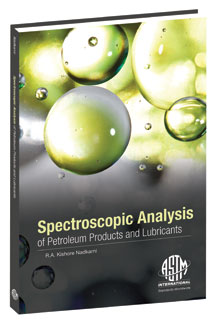
Spectroscopic Analysis of Petroleum Products
Techniques and Applications
A discussion of spectroscopic techniques - both theoretical and practical - used in oil industry laboratories can be found in a new ASTM International publication, Monograph 9, Spectroscopic Analysis of Petroleum Products and Lubricants. The work covers both the fundamentals of techniques and their application in oil analysis.
The techniques discussed in Monograph 9, which are applied in the oil industry by refinery and chemical plant laboratories as well as in commercial and R&D laboratories, provide information about elemental content, chemical composition and molecular speciation. That information serves to determine whether a fuel meets applicable specifications; it also aids in making process decisions. Spectroscopic analyses have the advantage that they can be automated, and they often replace lengthy chemical preparations while simultaneously providing quantitative data on many product parameters.
R.A. Kishore Nadkarni, Ph.D., Monograph 9 editor and chapter author, developed the book to address all aspects of modern spectroscopic methods used to analyze petroleum products and lubricants. Nadkarni is a longtime ASTM International member, an ASTM fellow and Award of Merit recipient, and president of Millennium Analytics Inc., East Brunswick, N.J., a consulting firm specializing in fossil fuel analyses and quality management.
The book details basic principles and application examples, and it contains extensive bibliographies for further reference. Nadkarni says, "This is the first book which comprehensively covers all aspects of modern spectroscopic techniques used in oil industry analyses."
Monograph 9 describes 12 spectroscopic techniques, including nuclear magnetic resonance, Fourier-transform infrared spectroscopy and isotope dilution mass spectrometry. Individual chapters also cover the analysis of biofuels, used oils and crude oils, and the determination of such elements as sulfur and mercury. Fundamentals of analytical chemistry such as calibration, quality control, preparation of reference materials and proficiency testing are also included in the work.
Respected scientists in the field contributed their insights on the various techniques and their applications covered in the book's 24 chapters. The result, Nadkarni notes, should be of use to oil industry professionals and as a possible textbook for university graduate courses in analytical or petroleum chemistry.
 SN Home
SN Home Archive
Archive Advertisers
Advertisers Masthead
Masthead RateCard
RateCard Subscribe
Subscribe Email Editor
Email Editor